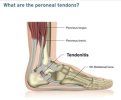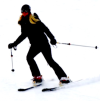@edelweissmaedl, I'm wondering if you overuse your calf muscles and that causes your discomfort.
When they calf muscles contract, they open the ankle to point the toes ("plantarflexing"). If the foot is held in a ski boot attached to skis, and the skis are solidly planted while sliding on the snow, that calf contraction opens the ankle, moves the knee backwards, and tilts the lower leg back.
When running or walking, where the shoe is not solidly planted on the ground, the contracting calf muscle points the toe and lifts the heel. This movement is what propels the walker/runner forward. Calf muscle contraction is essential to forward propulsion when walking and running.
When skiing, the contracting calf muscle opens up the ankle inside the boot, moves the knee backwards and tilts the lower leg backwards at its top, moves the body weight backwards, pushes the calf against the back of the cuff, and lifts the heel inside the boot if it's not held down by tightly clamped buckles. All of this puts the skier in the back seat. Does any of this sound familiar?
The way to stop contracting the habit of calf muscles when skiing is to do the opposite, close the ankle consciously by contracting the anterior tibialis muscle on the front of the shin. This closes the ankle, tilts the lower leg forward, brings the knee forward, and puts the shin in contact with the tongue of the boot. Maintaining this contraction also helps push the heel back and down onto the floor of the boot. The visible result for onlookers is the skier's lower leg tilts forward, not upright and definitely not backwards. Forward is good. Upright and backwards are not.
Actively closing the ankle ("dorsiflexing") is not something anyone walking or running does. Horse back riding requires it, but I don't know of another sport that does. So it's an unfamiliar thing to learn to do when building skiing skills. Do you work on keeping shin-tongue contact as you ski? How successful are you at this? Do you ever feel back-of-cuff contact with your calf?





